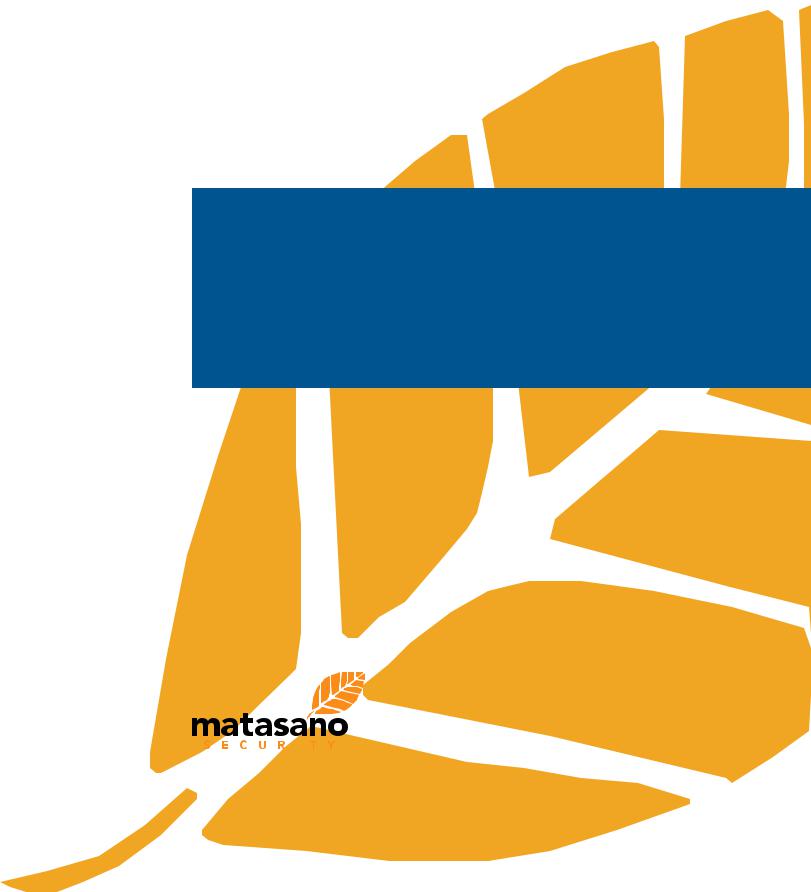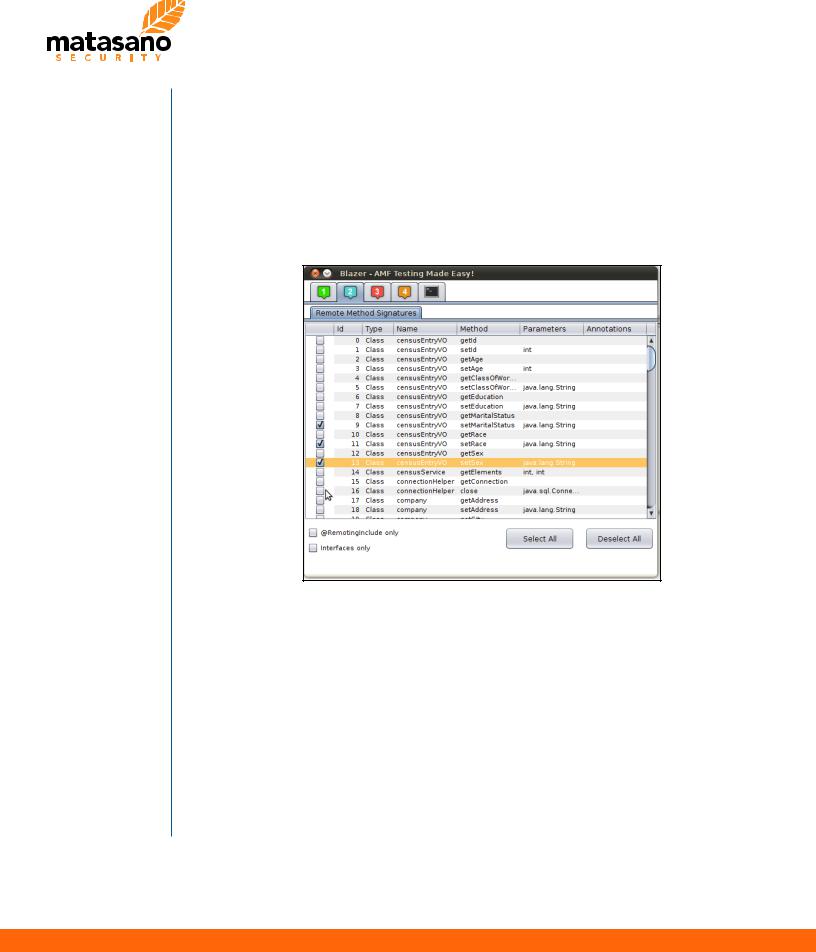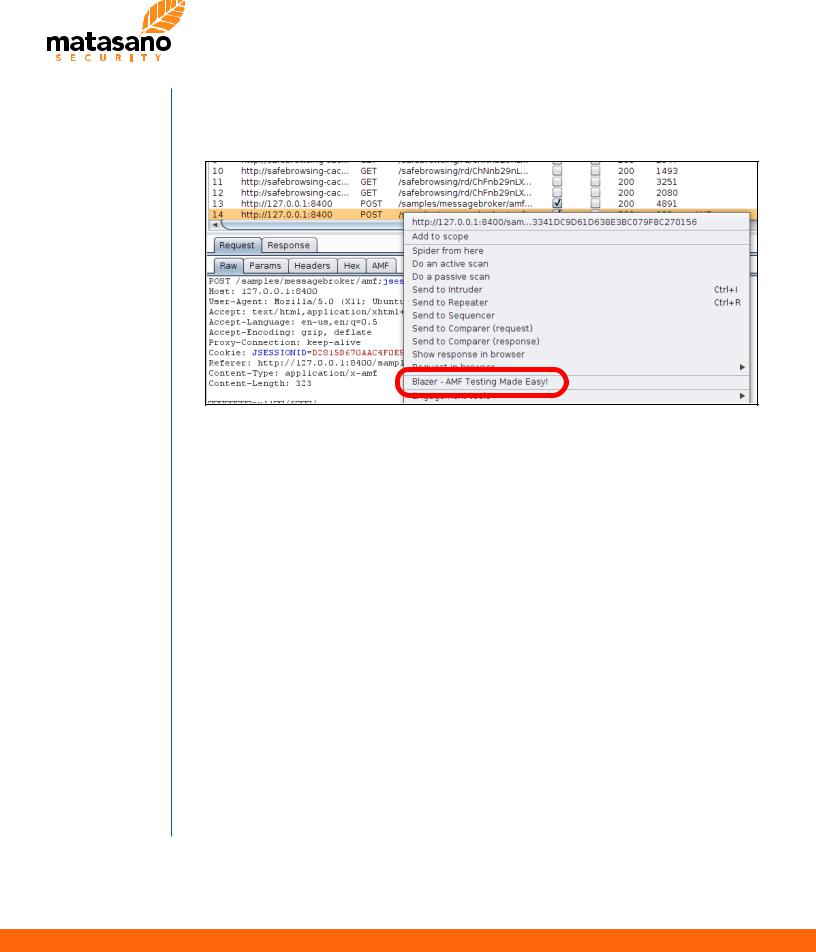
BH_US_12_Carettoni_AMF_Testing_WP
.pdf
PREPARED BY
Luca Carettoni, Matasano Security luca@matasano.com
AMF TESTING MADE EASY!
Monday, July 23, 2012
|
|
|
|
|
info@matasano.com |
39 West 14th St. |
53 W. Jackson |
756 California St |
|
(888) 677-0666 |
|
Suite 202 |
Suite 1850 |
Suite A |
|
|
New York, NY |
Chicago, IL |
Mountain View, CA |
|
|
10011 |
60604 |
94041 |
|
|
|
|
|
|
|
|
|
|

AMF TESTING MADE EASY!
Since its introduction in 2002, Action Message Format (AMF) has attracted the interest of developers and bug-hunters. Techniques and extensions for traditional web security tools have been developed to support this binary protocol. In spite of that, bug hunting on AMF-based applications is still a manual and time-consuming activity. Moreover, several new features of the latest specification, such as externalizable objects and variable length encoding schemes, limit the existing tools.
This research aimed at improving the current state of art, introducing a novel testing approach as well as a new tool named Blazer. Our automated gray-box testing technique allows security researchers to build custom AMF messages, generating dynamically objects from method signatures. The approach has been implemented in a Burp Suite plugin which currently supports Adobe BlazeDS, a well-known Java remoting technology. Using Blazer, testing AMF-based applications is easier and more robust. The tool consents to improve the coverage and the effectiveness of fuzzing efforts targeting complex applications.
This paper focuses on the newly introduced methodology and explain how to use the tool during gray-box testing of AMF-based applications. It is assumed that readers of this document have a basic knowledge and understanding of Adobe Flex and the AMF format.
The following summarizes the outline of this paper:
•Technology overview
Brief overview of the technology context. Introduction to the AMF specification, Flex remoting and Adobe BlazeDS
•State of art
Summary of the state of art, including existing tools and limitations of current techniques
•Testing AMF-based applications
Description of a generic methodology for gray-box testing
•Blazer
Introduction to Blazer, detailing core techniques and features
•How to use Blazer
Two practical examples on how to use Blazer to test authorization and input validation flaws
•Conclusion
Final considerations and possible future improvements
2

TECHNOLOGY OVERVIEW
The research outlined in this paper focuses on the latest AMF specification and Adobe BlazeDS/ LiveCycle Data Services, a widely used server-side Java implementation. Some of the technical details discussed in this paper are specific to Adobe’s implementation. However, our approach and our tool can be applied on other Java server-side frameworks (e.g. Granite) and can be easily ported to other programming languages (RubyAMF, FluorineFX, amfPHP, etc.).
AMF Specification
As described in the Action Message Format (AMF) specification document [1], AMF is a compact binary format that is used to serialize ActionScript object graphs. ActionScript is an object -oriented programming language used within Adobe Flash applications. ActionScript object graphs are based on named properties in the form of key-value pairs.
AMF represents an efficient mechanism to save and retrieve the state of an application across sessions or to allow two endpoints to communicate through the exchange of strongly typed data. Nowadays, AMF is primarily used for accessing remote services and provide RPC (Remote Procedure Call) capabilities. Since its introduction, a standard Flex application can interact with complex back-end services and legacy applications. As a binary protocol with optimized objects compression, AMF allows faster data transfer comparing to traditional text-based protocols. Also, the native support of ActionScript objects serialization and deserialization improves the overall performance.
The first version of AMF, referred as AMF0, was officially released in 2002 with Macromedia Flash Player 6. Due to new data types and language features of ActionScript 3.0, Adobe released an updated version (AMF3) with Flash Player 9. Major improvements and changes include the possibility to send objects traits, string and other data type by reference. Also, AMF3 introduces variable length encoding schemes and support for “flash.utils.IExternalizable”.
Adobe Flex Remoting
The combination of highly responsive client and server side components allow remote procedure invocation through Flex Remoting. This mechanism allows client-side applications to make asynchronous requests to remote services that process and return data. As long as the serverside technology has been implemented according to the Flex remoting specification, any Flex client or AIR application can communicate with remote services and inter-exchange data.
3

Adobe BlazeDS
In the effort of improving remoting and messaging capabilities of the Flex framework, Adobe released a open-source implementation named “BlazeDS” in addition to the commercial “LiveCycle ES” version. BlazeDS core features include the RPC and the messaging services. In this context, remoting allows a Flex application to invoke directly methods of Java objects deployed within a traditional J2EE application server (e.g. Apache Tomcat). The server-side components of BlazeDS run in a standard web application container, in the form of Java classes, JAR libraries and XML-based configuration files (typically within WEB-INF/lib, WEB-INF/flex, WEB-INF/ classes). As detailed in the Adobe BlazeDS Developer Guide [2], to send messages across the network, clients use the concept of channels. A channel encapsulates message formats, network protocols, and network behaviors to decouple them from services, destinations, and application code. A channel formats and translates messages into a network-specific form and delivers them to an endpoint on the server. Channels communicate with Java-based endpoints on the server. An endpoint unmarshals messages in a protocol-specific manner and then passes the data in generic Java form to the message broker. The message broker determines where to send messages and routes them to the appropriate service destination (Java class and method).
Supported AMF request/response types include:
•CommandMessage
•RemotingMessage
•AcknowledgeMessage
•ErrorMessage
•HTTPMessage / SOAPMessage
Each AMF remoting message can be uniquely identified by the following attributes:
•endpoint (e.g. http://127.0.0.1:8080/myApp/messagebroker/amf )
•destination service (e.g. echoService )
•operation and parameters (e.g. String echo(String input) )
Although software vulnerabilities in the BlazeDS framework have been uncovered in the past [3], this research focuses on software vulnerabilities at the application level only.
4

STATE OF ART
In recent years, Flex clients evolved from simple shiny user interfaces to large applications managing complex and sensitive data. As a result, we have observed an increase of interest for developers and breakers to evaluate the security posture of AMF-based applications. At OWASP AppSec 2007, Stefano di Paola presented one of the first research targeting the Flash framework [4]. During Blackhat USA 2008, a talk titled “Adobe Flex, Amf 3 And Blazeds An Assessment” [5] defined the technology stack as “an unexpectedly large attack surface” to emphasize the extend surface available to attackers. In 2009, Deblaze [6] was released by Jon Rose. The tool allows to enumerate remote methods through a combination of brute-forcing techniques and decompiling the client-side code. In 2010, Marcin Wielgoszewski presented one of the most comprehensive research targeting Flex-based applications [7]. In particular, he pointed out the need of building custom clients that would allow to define custom Java objects, in addition to primitive types. Starting from version 1.2.124 [8], the popular Burp Suite added support to visualize and tamper AMF requests and responses. Moreover, the Burp Scanner module was updated to place automatically attack payloads within string-based AMF values. Other tools have been also updated in order to support this technology, including Charles Proxy, WebScarab and Fiddler2 (AMFParser plugin). Particularly interesting is the idea implemented by Pinta [9], a cross-platform Adobe AIR application that allows to debug AMF calls.
A common methodology to perform black-box security testing against AMF applications include:
•Enumeration
•Retrieving endpoints, destinations and operations from the traffic
•Decompiling Flex application components
•Brute-forcing endpoint, destination and operation names
•Traffic inspection and tampering
•Using network packet analyzers
•Using HTTP proxies
Although this approach can be used during black-box assessment with limited knowledge of the target, it has several disadvantages. Testing a large application is a time consuming task as it requires to invoke all application functionalities, observe the generated traffic and perform tampering. In case of operations using custom objects as arguments, reverse-engineering may be also required in order to build valid AMF messages. As a result, manual parameter tampering is usually limited to just few messages with primitive types and simple Java objects. Another
5

drawback is related to “hidden” server-side functionalities that are impossible to uncover by decompiling the Flex client or observing the network traffic.
Although the current literature includes AMF testing techniques and tools, none of the previous research was focused on coverage and automation. In addition, most of the tools available have serious limitations while dealing with custom objects, which is a common practice in enterprise software. For instance, popular web security proxies do not properly handle complex AMF3 messages and they are not even able to display those custom objects thus tampering cannot be easily performed.
“Life is pain, highness. Anyone who tells you differently is selling something.” -W. Goldman
6

TESTING AMF-BASED APPLICATION
As outlined in the previous section, testing AMF-based applications is still a manual and timeconsuming activity. If a security assessment is focused on coverage, the tester has to be able to generate valid AMF messages for all destinations. During several real-life engagements working with complex AMF-based applications, we have encountered enterprise-grade software with more than 500 remote invokable methods and more than 600 custom Java objects exchanged by the client and server.
Introducing a generic methodology for gray-box testing
Performing vulnerability research on such extended attack surface requires a new approach that would allow to overcome the limitations of current techniques. In particular, this research focuses on improving the coverage and the effectiveness of fuzzing efforts by designing and developing a tool, able to automatically generate valid AMF messages from operation signatures (e.g. Java methods in case of BlazeDS). Handling custom objects and other features of the AMF3 specification is crucial for auditing complex software and it was considered as requirement during the development of the tool.
The author assumes that the source code or the portable code (bytecode) for the application under scrutiny is available. During vulnerability research analysis, this is a realistic assumption as the tester has usually full control over the testing environment.
The ability of generating valid AMF messages for all endpoints, destinations and operations allows security researchers to cover the following test areas:
•Authentication
Authentication and session management in BlazeDS applications is usually managed by the underline application server (e.g. Apache Tomcat) or web framework (e.g. Spring) via traditional session tokens. By generating valid messages and verifying that all operations require a valid cookie, except those specifically intended to be public, a tester can verify that no operations are exposed to unauthorized users.
•Access control and authorization
By generating valid messages for all operations available to multiple low-privileges users as well as to administrators, a security researcher can detect horizontal and vertical escalation bugs. This allows the tester to uncover access control failures between users in the same tenancy and users between tenancies. In real-life situations, the tool should also be able to generate arbitrary operation parameters in order to test direct object references (DOR) bugs. For example, let’s imagine a remote method for users management. The tool should be able to
7

build a custom Java object (e.g. “User”) containing an attribute to identify the user id (e.g. “userID” as integer) and the user’s roles (e.g. “Roles”, another custom Java object).
•Error handling and information disclosure
By sending properly formatted AMF messages with invalid content (e.g. an invalid “userID”), the tester can observe all possible server responses. This may lead to the discovery of Java stack traces or verbose error messages that may facilitate further attacks. It is important to note that we are targeting the application, thus the tool should not trigger errors or exceptions at the BlazeDS framework level.
•Input validation
Fuzzing with common attack patterns for traditional web application vulnerabilities (e.g. SQL injection, LDAP injection, etc.) allows to verify that all input validation failures result in input rejection or input sanitization. Thus, the tool should be able to tamper or mutate properly built AMF messages with malicious strings. Due to Java strong typing, injection would typically occur within String arguments. However, all data type are relevant. For instance, integer overflow bugs in Java application may affect the business logic and may have drastic consequences. Also, BlazeDS endpoints may expose native code through Java Native Interface (JNI) calls.
•Output Encoding
Under some circumstances, it is important to verify that all untrusted data that are output need to be properly escaped for the specific application context. This task requires fuzzing and manual or semi-automatic evaluation of the resulting AMF responses. Although cross-site scripting and cross-site flashing affecting Flex applications have become less relevant thanks to the hardening introduced by recent Flash framework versions, these classes of vulnerabilities may still be relevant for particular use cases.
8

BLAZER
Considering the previously mentioned requirements, Blazer was designed and implemented to make AMF testing easy, and yet allows researchers to control fully the entire security testing process.
Blazer has been developed in Java as a Burp Suite plugin [10] and released under the GNU General Public License [11]. As it is highly integrated in a well-known testing suite, web security practitioners can start to use the tool with minimal setup in few seconds.
Blazer Burp Plugin Look and Feel
On Windows, it is possible to launch Burp and Blazer with the following command:
java -classpath burp.jar;Blazer.jar burp.StartBurp
On Linux and Mac OS X, use a colon character instead of the semi-colon as the classpath sepa-
rator:
java -classpath burp.jar:Blazer.jar burp.StartBurp
Burp plugins are supported by both versions (free and professional) of the Burp Suite. All major operating systems (Windows, Mac, Linux) with standard Oracle JRE installed are supported by
the current version of Blazer.
9

Upon launching Burp, it is possible to verify that Blazer was properly loaded by checking the “Alerts” notification tab. At this point, Blazer can be invoked by using a context menu available from within Burp tools.
Blazer Context Menu From Proxy History
Please note that the tool detects and verifies the presence of valid Flex’s “RemotingMessage” objects within requests/responses captured by Burp.
Blazer can be fully configured and used from the plugin GUI. Traditional standard output and error streams provide further details during the automatic objects generation, messages creation and transmission.
At the top of Blazer’s window, five tabs guide the user throughout the tool configuration:
1. Application Libraries
This allows to include all application artifacts, including application classes implementing the remote methods as well as application libraries. The current release of Blazer supports JAR files only. From the user’s perspective, this is typically what is available in the application server webroot, under “/WEB-INF/”.
2. Remote Method Signatures
Blazer automatically retrieves public method signatures from the application libraries. This tab allows to select all methods under scrutiny, filtering based on annotation or type.
3. General Options and Data Pools
Object generation and fuzzing can be precisely customized from the user interface. For in-
10
